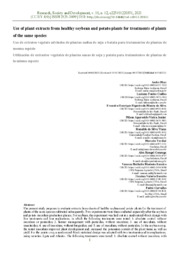Use of plant extracts from healthy soybean and potato plants for treatments of plants of the same species.
Use of plant extracts from healthy soybean and potato plants for treatments of plants of the same species.
Autoria: MAY, A.; COELHO, L. F.; SILVA, E. H. F. M. da; VIEIRA JUNIOR, N. A.; VIANA, R. S.; VERDIAL, M.; GONZAGA, A. R.; BORATTO, V. N. M.; BORATTO, I. V.; CARVALHO, P.
Resumo: Abstract: The present study proposes to evaluate extracts from shoots of healthy soybean and potato plants for the treatment of plants of the same species cultivated subsequently. Two experiments were thus conducted separately after the soybean and potato inoculum production phases. For soybean, the experiment was laid out in a randomized-block design with five treatments and four replications, in which the following treatments were tested: 1. absolute control without inoculum or pesticides; 2. farmer management with pesticides, without inoculum; 3. use of inoculum, without insecticides; 4. use of inoculum, without fungicides; and 5. use of inoculum, without pesticides. In the soybean crop, the tested inoculum improved plant development and, increased the potassium content of the plant tissue as well as yield. For the potato crop, a randomized-block statistical design was adopted with two treatments and ten replications, using varieties Ágata and Atlantic. The following treatments were tested: 1. absolute control without inoculum, with pesticides; and 2. use of inoculum (foliar spraying), with pesticides. With the use of inoculum, varieties Ágata and Atlantic showed distinct responses regarding disease incidence and yield. Late blight was the disease that most affected both varieties, but only Atlantic showed a reduction in its incidence when the inoculum was applied. Variety Atlantic also exhibited an increase in the most valued commercial calibers, besides an increase in yield, with the use of the tested inoculum. Cultivar Ágata showed a marked reduction in tuber defects with the use of the inoculum on the plants.
Ano de publicação: 2021
Tipo de publicação: Artigo de periódico
Unidade: Embrapa Meio Ambiente
Palavras-chave: Brotacao, Diseases, Doença de Planta, Extrato Vegetal, Pulverização Foliar, Tratamento de Semente, Yield
Observações
1 - Por padrão são exibidas publicações dos últimos 20 anos. Para encontrar publicações mais antigas, configure o filtro ano de publicação, colocando o ano a partir do qual você deseja encontrar publicações. O filtro está na coluna da esquerda na busca acima.
2 - Para ler algumas publicações da Embrapa (apenas as que estão em formato ePub), é necessário ter, no celular ou computador, um desses softwares gratuitos. Sistemas Android: Google Play Livros; IOS: iBooks; Windows e Linux: software Calibre.
Acesse outras publicações
Acesse a Base de Dados da Pesquisa Agropecuária (BDPA) para consultar o acervo completo das bibliotecas da Embrapa.

